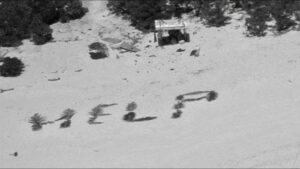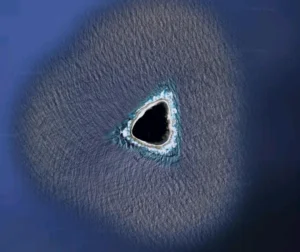“What we have here are the graves for the prisoners” , Nurshat Jumadilova tells us: “Those that lived at camps at Karlag.”
We were standing next to a rusty sign with just a number on it. We were surrounded by the flat grassy step and the day was sunny and warm. It was really hard to understand that this serene place was a sign of true evil. Professor Nurshat Jumadilova from the Bolashak University continued solemnly and concentrated:
“There are gravestones of those that are buried here, labeled with numbers which relate to the cases against them. Their clothes were marked up with numbers, so the number corresponded to the case against them. There are lots of different nationalities buried here. Russians, Belorussians, Ukrainians and many other nationalities. At that time they were only marked like that – no name, no surname. So it’s very difficult to say who is in which grave, or where they’re from?”
“We have a map, which tells us that there are prisoners buried here” , Nurshat explains with a strong voice, she has been here many times, but for us, it was beginning to feel profoundly and deeply sad: “We also have some modern graves here now, and these markers relate to these recent graves. The graves which are from the camp burials are the old rusty ones with numbers on them. It is only by those numbers we can then look at the archives, but they’re only stored in the KGB archives, exactly who is in which grave.”
Since I travelled down the Kolyma River in 2004-5 my views on the former Soviet Union had been mixed. Even though most books I had read about this era have been very negative, protraying the insanity of the leaders and the system, though when spending a year along the Kolyma, where Stalin actually placed his worst reputed camps, meeting local people and hearing their stories…well…it had changed my views quite a lot. First of all, I was surpsied that so many of the people we met, missed the old Soviet time. Secondly many of them missed Stalin himself and did not believe the bad news about him that had come to light after the fall of the empire. Thirdly, it seemed that the indigenous people better than most, found a place in the empire due to the communist dogma of sharing everything, which they always had done anyone. And they all had enough to survive, which isn´t the case today. So my feelings were ambivalent really up until this visit during the summer of 2015. When I now had a chance to put everything I new in to the right context, all I felt was sadness. Though I see myself as non-politcal, if I have to choose I am definitely more to the left than to the right. But to believe in a system run by leaders who chose and surrounded themselves by the most stupid and volatile people left after sending almost all intellectuals to prison, impossible. And, standing there on the Steppe outside Karabas, this reality hit home.
“Behind you there’s a quarry where the prisoners from the Karabas camp used to work. This was a transit area, where the prisoners were first brought, dressed and issued with bedding. Only after that they were taken by vehicle to different parts of the camp in the Karaganda region. They carried out work at the quarry here, breaking up stones into gravel to build roads. Everything made out of local materials. Bear in mind in those times, there was a shortage of clothes, footwear and so, for this reason they ended up staying in this transit camp for months at a time. So, to make sure they weren’t idle they made them work, here they opened a tailor shop, and a shoemakers shop. They mainly worked on camp maintenance as they weren’t ready to be sent out to the main camp. And they were used for hard labour in the quarry.”
I have said it before, Nurshat is one of the most interesting and brave human beings I have ever come across. Her family history is dominated by Stalin´s Gulags and the controlling manner of the Soviet Union. She says exactly what is in her heart, no matter what consequences it may have and her intelligence and capacity to put things in its right context, is extra ordinary.
“So this was a camp in itself?” Theo asks and Nurshat replies quickly: “No, no, this is a distribution area, so they -the rpioners- were brought in to this point and from here they were sent out to various areas in Karlag. But, most of them…all these signs that were placed here, some have been moved, some have been lost, people have taken them…….Generally they were buried in group graves, they didn’t make individual graves…If ten to fifteen people died they wouldn’t dig them each a grave, they dug one huge trench, a hole, and they were all put into the same hole and they’d put one marker on the top.”
This really upset Ken, who hissed:
“They didn´t even have the dignity to bury them properly!”
Nurshat continues recounting the history of this part of Karlag:
“Each camp had its own farm system and the produce from these farms was sent to different countries. This helped the economy for the Soviet Union and not all the produce was for the camp, you understand! The camp was able to generate some money. There’s no mention of the prisoners being given nutritious food in the archives, I’ve seen a lot of archive documents, but I’ve not seen any mention of it in them.”
The high walled camp were the prisoners were first brought, most of the time by train, is still in existence today. As a prison with high watch towers and barbed wire. We went there and Nurshat asked the guards and the camp commander if we could come in, so she could show us what it looked like today and what it used to be. But we need permits we didn´t have. Basically Karabass was a collection point for the new prsioners which had been sent to Karlag. Many of them famous today as Aleksandr Solzhenytsin and Alexander Dolgun to mention a few. And Testuro came through here. This was also the place where the different camp commanders came to find prisoners who were suited for jobs they needed done. Like carpenters, miners and so on. The ones nobody wanted was the elderly and disabled. It must have been just like a slavemarket one sees in the movies from the American South or Africa. But freezing cold.
“Right now we are at the Karabas Station” , Nurshat tells us and backs up my memory of what I had read about Karabas: “This place used to be called The gate of KARLAG, because this was a transit point. Prisoners came from all parts of Soviet Union, all prisoners of war, political prisoners and criminals were sent here, and then they were distributed to the different camps of KARLAG. When people were brought here, the camp divisions were not ready to accept the prisoners, although they stayed here for months. They were poorly fed. Prisoners suffered from pediculosis and bedbugs were everywhere. At present this prison is operate. It contains criminals.”
Original story at https://www.mikaelstrandberg.com/2016/01/31/karabas/






